Unit 5 First AIDS
文档属性
| 名称 | Unit 5 First AIDS | 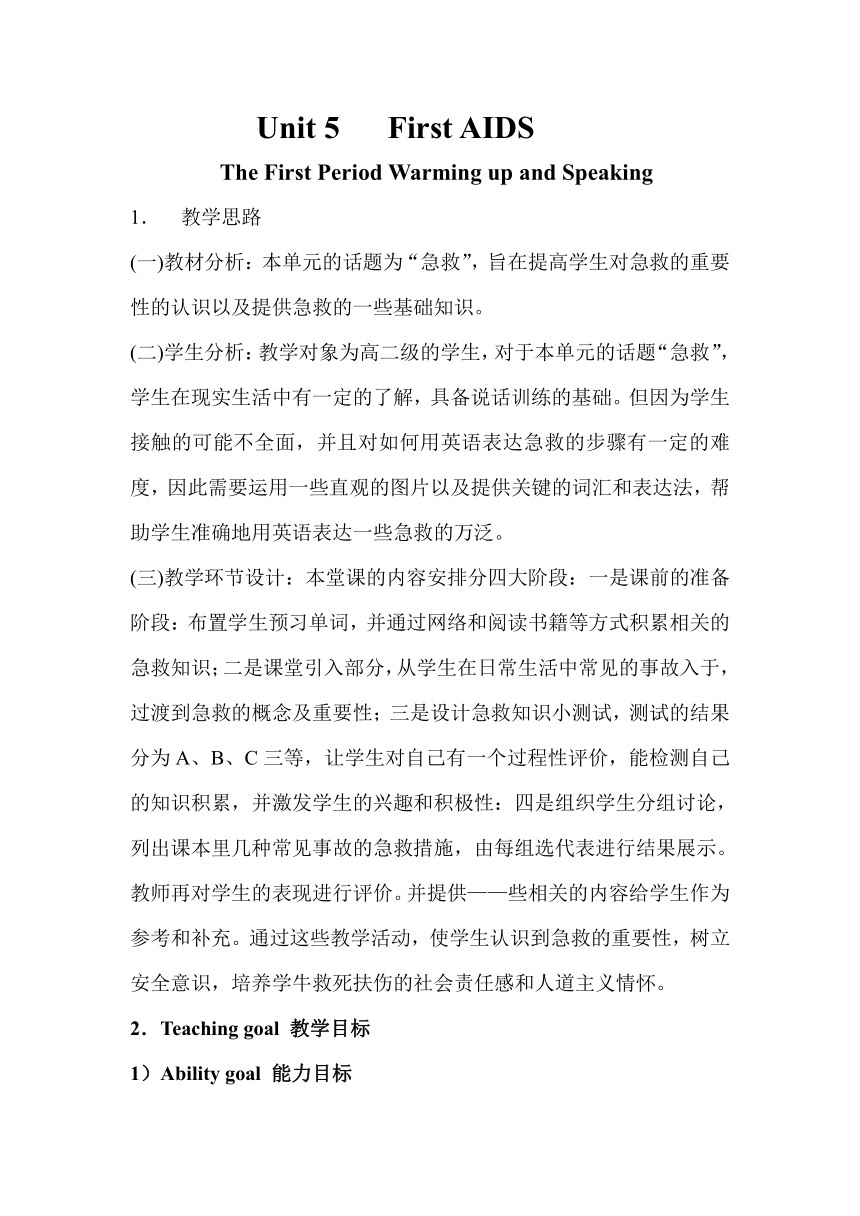 | |
| 格式 | rar | ||
| 文件大小 | 11.6KB | ||
| 资源类型 | 教案 | ||
| 版本资源 | 人教版(新课程标准) | ||
| 科目 | 英语 | ||
| 更新时间 | 2008-09-20 09:20:00 | ||
图片预览

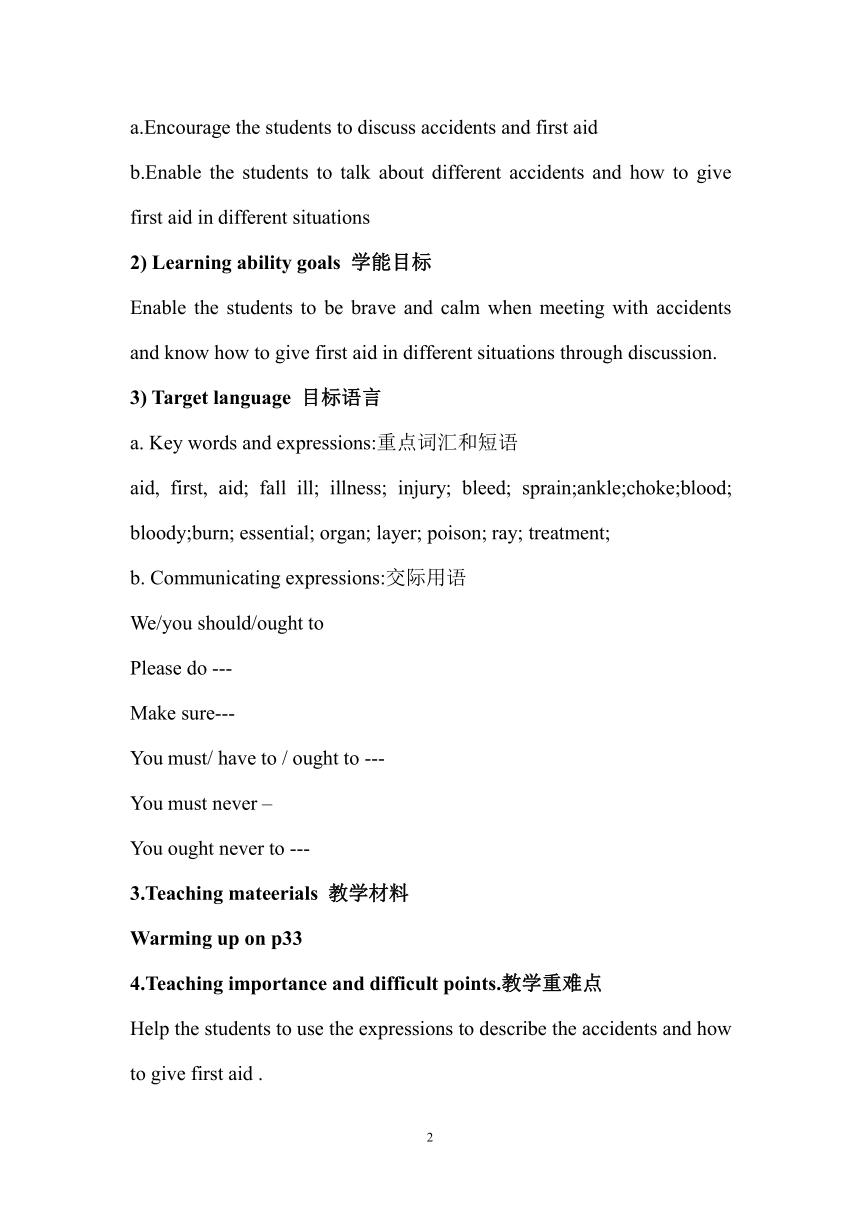
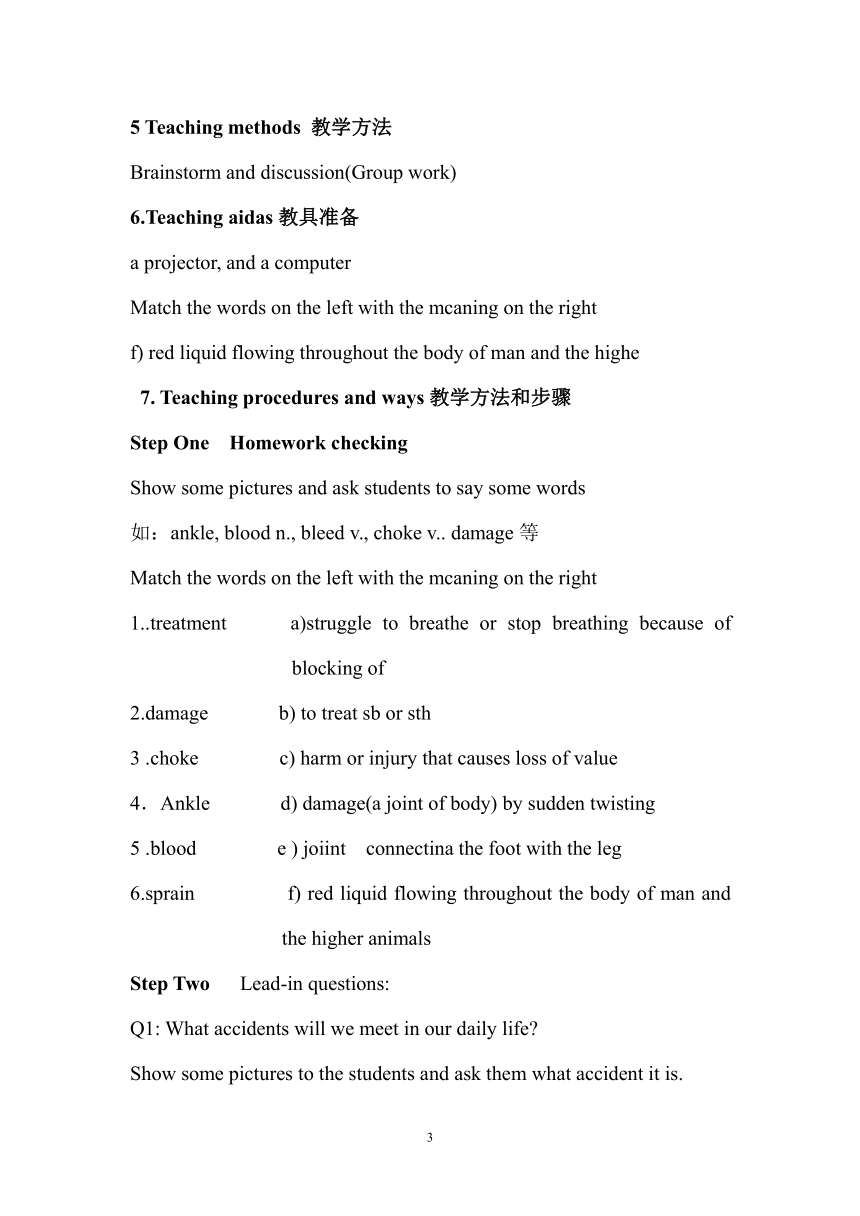
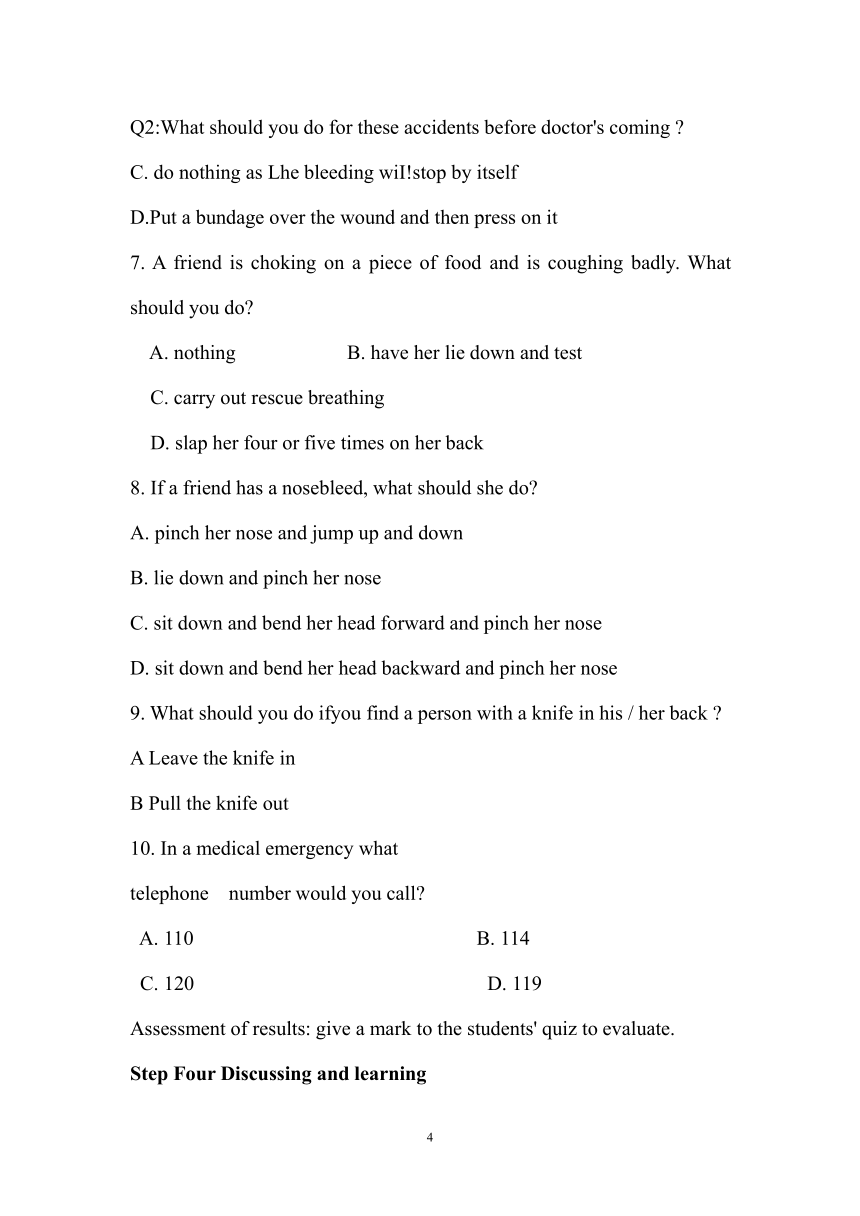
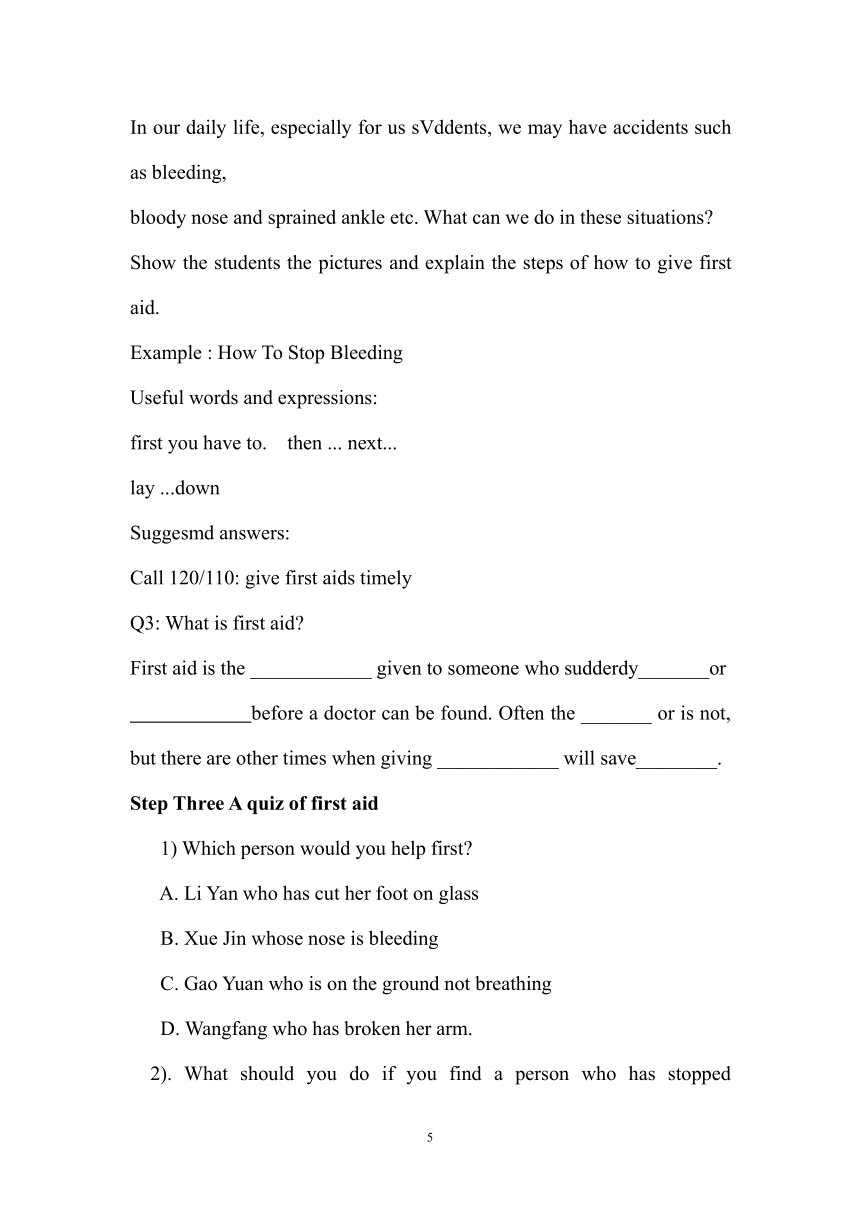
文档简介
Unit 5 First AIDS
The First Period Warming up and Speaking
1. 教学思路
(一)教材分析:本单元的话题为“急救”,旨在提高学生对急救的重要性的认识以及提供急救的一些基础知识。
(二)学生分析:教学对象为高二级的学生,对于本单元的话题“急救”,学生在现实生活中有一定的了解,具备说话训练的基础。但因为学生接触的可能不全面,并且对如何用英语表达急救的步骤有一定的难度,因此需要运用一些直观的图片以及提供关键的词汇和表达法,帮助学生准确地用英语表达一些急救的万泛。
(三)教学环节设计:本堂课的内容安排分四大阶段:一是课前的准备阶段:布置学生预习单词,并通过网络和阅读书籍等方式积累相关的急救知识;二是课堂引入部分,从学生在日常生活中常见的事故入于,过渡到急救的概念及重要性;三是设计急救知识小测试,测试的结果分为A、B、C三等,让学生对自己有一个过程性评价,能检测自己的知识积累,并激发学生的兴趣和积极性:四是组织学生分组讨论,列出课本里几种常见事故的急救措施,由每组选代表进行结果展示。教师再对学生的表现进行评价。并提供——些相关的内容给学生作为参考和补充。通过这些教学活动,使学生认识到急救的重要性,树立安全意识,培养学牛救死扶伤的社会责任感和人道主义情怀。
2.Teaching goal 教学目标
1)Ability goal 能力目标
a.Encourage the students to discuss accidents and first aid
b.Enable the students to talk about different accidents and how to give first aid in different situations
2) Learning ability goals 学能目标
Enable the students to be brave and calm when meeting with accidents and know how to give first aid in different situations through discussion.
3) Target language 目标语言
a. Key words and expressions:重点词汇和短语
aid, first, aid; fall ill; illness; injury; bleed; sprain;ankle;choke;blood; bloody;burn; essential; organ; layer; poison; ray; treatment;
b. Communicating expressions:交际用语
We/you should/ought to
Please do ---
Make sure---
You must/ have to / ought to ---
You must never –
You ought never to ---
3.Teaching mateerials 教学材料
Warming up on p33
4.Teaching importance and difficult points.教学重难点
Help the students to use the expressions to describe the accidents and how to give first aid .
5 Teaching methods 教学方法
Brainstorm and discussion(Group work)
6.Teaching aidas教具准备
a projector, and a computer
Match the words on the left with the mcaning on the right
f) red liquid flowing throughout the body of man and the highe
7. Teaching procedures and ways教学方法和步骤
Step One Homework checking
Show some pictures and ask students to say some words
如:ankle, blood n., bleed v., choke v.. damage等
Match the words on the left with the mcaning on the right
1..treatment a)struggle to breathe or stop breathing because of blocking of
2.damage b) to treat sb or sth
3 .choke c) harm or injury that causes loss of value
4.Ankle d) damage(a joint of body) by sudden twisting
5 .blood e ) joiint connectina the foot with the leg
6.sprain f) red liquid flowing throughout the body of man and the higher animals
Step Two Lead-in questions:
Q1: What accidents will we meet in our daily life
Show some pictures to the students and ask them what accident it is.
Q2:What should you do for these accidents before doctor's coming
C. do nothing as Lhe bleeding wiI!stop by itself
D.Put a bundage over the wound and then press on it
7. A friend is choking on a piece of food and is coughing badly. What should you do
A. nothing B. have her lie down and test
C. carry out rescue breathing
D. slap her four or five times on her back
8. If a friend has a nosebleed, what should she do
A. pinch her nose and jump up and down
B. lie down and pinch her nose
C. sit down and bend her head forward and pinch her nose
D. sit down and bend her head backward and pinch her nose
9. What should you do ifyou find a person with a knife in his / her back
A Leave the knife in
B Pull the knife out
10. In a medical emergency what
telephone number would you call
A. 110 B. 114
C. 120 D. 119
Assessment of results: give a mark to the students' quiz to evaluate.
Step Four Discussing and learning
In our daily life, especially for us sVddents, we may have accidents such as bleeding,
bloody nose and sprained ankle etc. What can we do in these situations
Show the students the pictures and explain the steps of how to give first aid.
Example : How To Stop Bleeding
Useful words and expressions:
first you have to. then ... next...
lay ...down
Suggesmd answers:
Call 120/110: give first aids timely
Q3: What is first aid
First aid is the ____________ given to someone who sudderdy_______or
before a doctor can be found. Often the _______ or is not, but there are other times when giving ____________ will save________.
Step Three A quiz of first aid
1) Which person would you help first
A. Li Yan who has cut her foot on glass
B. Xue Jin whose nose is bleeding
C. Gao Yuan who is on the ground not breathing
D. Wangfang who has broken her arm.
2). What should you do if you find a person who has stopped breathing
A. Run and find help.
B. Try to start his/her breathing.
3. When carrying out rescue breatbfing, how many times a minute should you blow air into the victim' s mouth
A.4 B.8 C.15 D.20
4. What is the most serious type of bum
A. first degree B. third degree
C. second degree D. all burns are serious
5. A friend took a hot pan off the fire with her bare hands
blistered and extremely paimCul. What should you do for her
A. tell her to put her fingers hq her mouth
B. take her to the doctor
C. put butter on her fingers and wrap then in bandages
D. put her burned ~mgers under cool water
6. How would you stop severe bleeding
A. cover the wound with plastic
B. wash the wound
Raise ---
apply pressure to ---
put andage on ---
How to stop bleeding
Her fingers are red and
First --- lay the person down., with the head slightly lower than the leg
Second ---raise the person's legs above the level of the heart to reduce the blood flow.
Third --- put a bandage on the wound and apply pressure to reduce the bleeding .
Group work Ss ideas for treatments
Divide the ss into three groups and ask them to describe what has happened and think of treatments for the accident in eac picture and then choose two ss to share their ideas with the classmates .
Q1. What has happen
Q2.What kind of first aid should you give in the following situations
common injuries advice
snakes bites
bleeding
a blood nose
a spained ankle
choking
a broken arm
They can use the following words and expressxons
lay down / squeeze out venom(毒液) / bandage---
bleeding: stop bleeding / press the wound / wash/dry
a bloody raise : sit down / tilt head forward slightly / pinch the nose---
a spained ankle : have – sit down ; raise --- ; put a bandage aroud --- ; put an ice pack on the ankle to ruduce ---
choking make --- spit by patting --- ; not talk or laugh when eating
a broken arm : not move --- if possible : keep – still usin a sling.
for treatments
their ideas with the classmates
snake bite
the heart to reduce the blood
o studcnts to share
still using a sling(r~ ]~ ~)
Please work in pairs to make a wtepnone conversaiion .... ~ - -'~ - it
speaks in moderately(5~_/~t~) slow, measured
....
First you have to --- then --- next ---
You should (not)--- You must never ---
make sure that --- Never --..
Please don' t ---
Presentation: ask representatives from each group to present their suggestions.
Then the teacher adds some tips for treatment the students have left out.
Step Five Talking
T: Life is precious and we should give first aid to anyone who is in trouble timely .
Remember no matter what happens, we should keep calm and brave.
Suppose your neighbour was standing on a table in the kitchen and was reaching up to the top cupboard and she fell. She hit her head badly. You are ringing the emergency number.
An example: An Emergency Call
Mrs Grant (G) is ringing the emergency number. Her daughter has had an accident in the kitchen and is unconscious.
The operator (O) always remains calm and speaks in moderately slow, measured tones.
O: Emergency. Can I help you
G: You've got to help me --- my daughter's had an accident. I don't know what to do
O: Now calm down. Tell me your name and phone number --- slowly.
G: Urnmm-- Sarah Grant. Oh, you've got to send an ambulance now.
O: Yes, I will. Now take a deep breath and tell me your phone number.
G: Yes, yes ... 6161 9486.
O: Good. Now tell me what's happened
G: Well, my dauoghter was standing on a table in the kitchen and and was reaching up to the top cupboard and she fell. She hit her head badly. she's unconscious.. shouted at her but she won't wake up. Oh, please hurry'.
O: Yes, we will ...
G: Oh thank you, thank you. Goodbye ...
leg looks strange --- maybe it's broken. And she hit her head --- she's unconscious.
O: [interrupts] No, no, don't hang up --- we need your address
G: Oh sorry, I'm just so worried. It's 12 Loft Street, East Horton.
O: Right. The ambulance is on its way.
G: Thanks so much. Goodbye.
O: Goodbye.
Step six Homework:
1 Making a first-aid kit kept ir, easy reach at home.
2 Preview Reading 1 First Aid for Burns
3 Think over the following question:
Is it necessary for the school to add first aid course to our curriculum Give your opinion.
PAGE
2
The First Period Warming up and Speaking
1. 教学思路
(一)教材分析:本单元的话题为“急救”,旨在提高学生对急救的重要性的认识以及提供急救的一些基础知识。
(二)学生分析:教学对象为高二级的学生,对于本单元的话题“急救”,学生在现实生活中有一定的了解,具备说话训练的基础。但因为学生接触的可能不全面,并且对如何用英语表达急救的步骤有一定的难度,因此需要运用一些直观的图片以及提供关键的词汇和表达法,帮助学生准确地用英语表达一些急救的万泛。
(三)教学环节设计:本堂课的内容安排分四大阶段:一是课前的准备阶段:布置学生预习单词,并通过网络和阅读书籍等方式积累相关的急救知识;二是课堂引入部分,从学生在日常生活中常见的事故入于,过渡到急救的概念及重要性;三是设计急救知识小测试,测试的结果分为A、B、C三等,让学生对自己有一个过程性评价,能检测自己的知识积累,并激发学生的兴趣和积极性:四是组织学生分组讨论,列出课本里几种常见事故的急救措施,由每组选代表进行结果展示。教师再对学生的表现进行评价。并提供——些相关的内容给学生作为参考和补充。通过这些教学活动,使学生认识到急救的重要性,树立安全意识,培养学牛救死扶伤的社会责任感和人道主义情怀。
2.Teaching goal 教学目标
1)Ability goal 能力目标
a.Encourage the students to discuss accidents and first aid
b.Enable the students to talk about different accidents and how to give first aid in different situations
2) Learning ability goals 学能目标
Enable the students to be brave and calm when meeting with accidents and know how to give first aid in different situations through discussion.
3) Target language 目标语言
a. Key words and expressions:重点词汇和短语
aid, first, aid; fall ill; illness; injury; bleed; sprain;ankle;choke;blood; bloody;burn; essential; organ; layer; poison; ray; treatment;
b. Communicating expressions:交际用语
We/you should/ought to
Please do ---
Make sure---
You must/ have to / ought to ---
You must never –
You ought never to ---
3.Teaching mateerials 教学材料
Warming up on p33
4.Teaching importance and difficult points.教学重难点
Help the students to use the expressions to describe the accidents and how to give first aid .
5 Teaching methods 教学方法
Brainstorm and discussion(Group work)
6.Teaching aidas教具准备
a projector, and a computer
Match the words on the left with the mcaning on the right
f) red liquid flowing throughout the body of man and the highe
7. Teaching procedures and ways教学方法和步骤
Step One Homework checking
Show some pictures and ask students to say some words
如:ankle, blood n., bleed v., choke v.. damage等
Match the words on the left with the mcaning on the right
1..treatment a)struggle to breathe or stop breathing because of blocking of
2.damage b) to treat sb or sth
3 .choke c) harm or injury that causes loss of value
4.Ankle d) damage(a joint of body) by sudden twisting
5 .blood e ) joiint connectina the foot with the leg
6.sprain f) red liquid flowing throughout the body of man and the higher animals
Step Two Lead-in questions:
Q1: What accidents will we meet in our daily life
Show some pictures to the students and ask them what accident it is.
Q2:What should you do for these accidents before doctor's coming
C. do nothing as Lhe bleeding wiI!stop by itself
D.Put a bundage over the wound and then press on it
7. A friend is choking on a piece of food and is coughing badly. What should you do
A. nothing B. have her lie down and test
C. carry out rescue breathing
D. slap her four or five times on her back
8. If a friend has a nosebleed, what should she do
A. pinch her nose and jump up and down
B. lie down and pinch her nose
C. sit down and bend her head forward and pinch her nose
D. sit down and bend her head backward and pinch her nose
9. What should you do ifyou find a person with a knife in his / her back
A Leave the knife in
B Pull the knife out
10. In a medical emergency what
telephone number would you call
A. 110 B. 114
C. 120 D. 119
Assessment of results: give a mark to the students' quiz to evaluate.
Step Four Discussing and learning
In our daily life, especially for us sVddents, we may have accidents such as bleeding,
bloody nose and sprained ankle etc. What can we do in these situations
Show the students the pictures and explain the steps of how to give first aid.
Example : How To Stop Bleeding
Useful words and expressions:
first you have to. then ... next...
lay ...down
Suggesmd answers:
Call 120/110: give first aids timely
Q3: What is first aid
First aid is the ____________ given to someone who sudderdy_______or
before a doctor can be found. Often the _______ or is not, but there are other times when giving ____________ will save________.
Step Three A quiz of first aid
1) Which person would you help first
A. Li Yan who has cut her foot on glass
B. Xue Jin whose nose is bleeding
C. Gao Yuan who is on the ground not breathing
D. Wangfang who has broken her arm.
2). What should you do if you find a person who has stopped breathing
A. Run and find help.
B. Try to start his/her breathing.
3. When carrying out rescue breatbfing, how many times a minute should you blow air into the victim' s mouth
A.4 B.8 C.15 D.20
4. What is the most serious type of bum
A. first degree B. third degree
C. second degree D. all burns are serious
5. A friend took a hot pan off the fire with her bare hands
blistered and extremely paimCul. What should you do for her
A. tell her to put her fingers hq her mouth
B. take her to the doctor
C. put butter on her fingers and wrap then in bandages
D. put her burned ~mgers under cool water
6. How would you stop severe bleeding
A. cover the wound with plastic
B. wash the wound
Raise ---
apply pressure to ---
put andage on ---
How to stop bleeding
Her fingers are red and
First --- lay the person down., with the head slightly lower than the leg
Second ---raise the person's legs above the level of the heart to reduce the blood flow.
Third --- put a bandage on the wound and apply pressure to reduce the bleeding .
Group work Ss ideas for treatments
Divide the ss into three groups and ask them to describe what has happened and think of treatments for the accident in eac picture and then choose two ss to share their ideas with the classmates .
Q1. What has happen
Q2.What kind of first aid should you give in the following situations
common injuries advice
snakes bites
bleeding
a blood nose
a spained ankle
choking
a broken arm
They can use the following words and expressxons
lay down / squeeze out venom(毒液) / bandage---
bleeding: stop bleeding / press the wound / wash/dry
a bloody raise : sit down / tilt head forward slightly / pinch the nose---
a spained ankle : have – sit down ; raise --- ; put a bandage aroud --- ; put an ice pack on the ankle to ruduce ---
choking make --- spit by patting --- ; not talk or laugh when eating
a broken arm : not move --- if possible : keep – still usin a sling.
for treatments
their ideas with the classmates
snake bite
the heart to reduce the blood
o studcnts to share
still using a sling(r~ ]~ ~)
Please work in pairs to make a wtepnone conversaiion .... ~ - -'~ - it
speaks in moderately(5~_/~t~) slow, measured
....
First you have to --- then --- next ---
You should (not)--- You must never ---
make sure that --- Never --..
Please don' t ---
Presentation: ask representatives from each group to present their suggestions.
Then the teacher adds some tips for treatment the students have left out.
Step Five Talking
T: Life is precious and we should give first aid to anyone who is in trouble timely .
Remember no matter what happens, we should keep calm and brave.
Suppose your neighbour was standing on a table in the kitchen and was reaching up to the top cupboard and she fell. She hit her head badly. You are ringing the emergency number.
An example: An Emergency Call
Mrs Grant (G) is ringing the emergency number. Her daughter has had an accident in the kitchen and is unconscious.
The operator (O) always remains calm and speaks in moderately slow, measured tones.
O: Emergency. Can I help you
G: You've got to help me --- my daughter's had an accident. I don't know what to do
O: Now calm down. Tell me your name and phone number --- slowly.
G: Urnmm-- Sarah Grant. Oh, you've got to send an ambulance now.
O: Yes, I will. Now take a deep breath and tell me your phone number.
G: Yes, yes ... 6161 9486.
O: Good. Now tell me what's happened
G: Well, my dauoghter was standing on a table in the kitchen and and was reaching up to the top cupboard and she fell. She hit her head badly. she's unconscious.. shouted at her but she won't wake up. Oh, please hurry'.
O: Yes, we will ...
G: Oh thank you, thank you. Goodbye ...
leg looks strange --- maybe it's broken. And she hit her head --- she's unconscious.
O: [interrupts] No, no, don't hang up --- we need your address
G: Oh sorry, I'm just so worried. It's 12 Loft Street, East Horton.
O: Right. The ambulance is on its way.
G: Thanks so much. Goodbye.
O: Goodbye.
Step six Homework:
1 Making a first-aid kit kept ir, easy reach at home.
2 Preview Reading 1 First Aid for Burns
3 Think over the following question:
Is it necessary for the school to add first aid course to our curriculum Give your opinion.
PAGE
2
